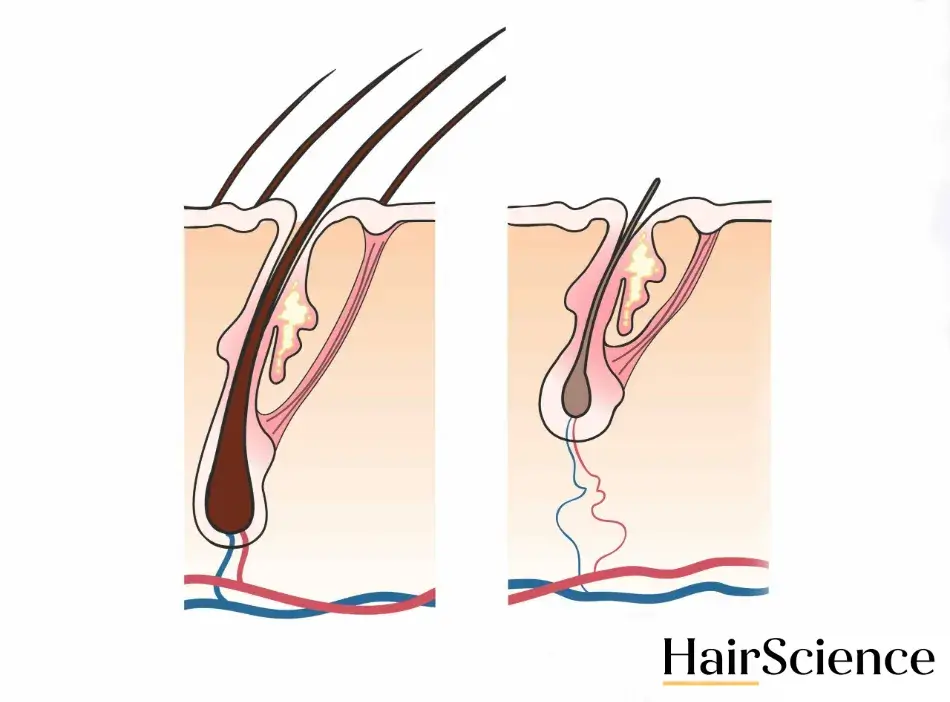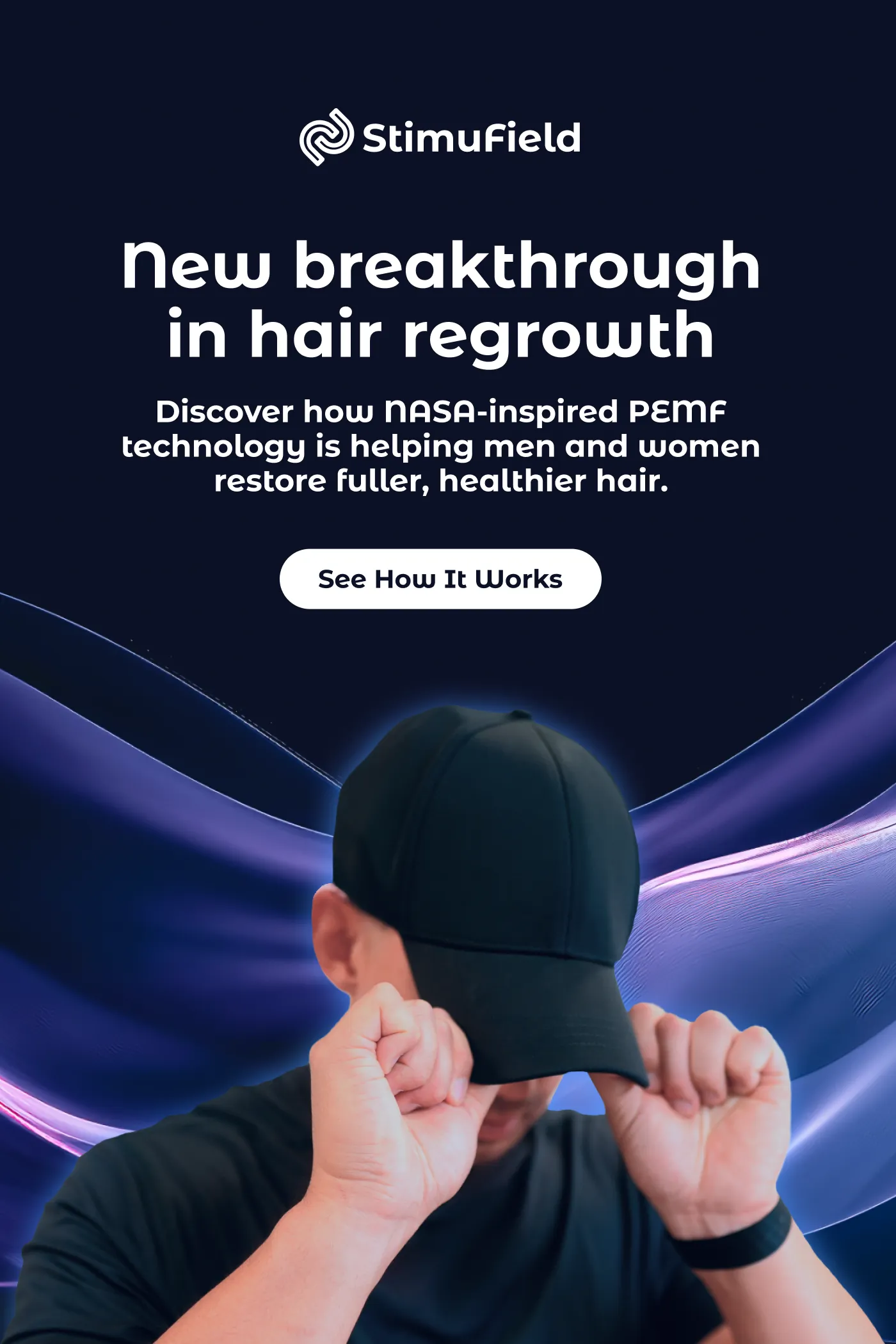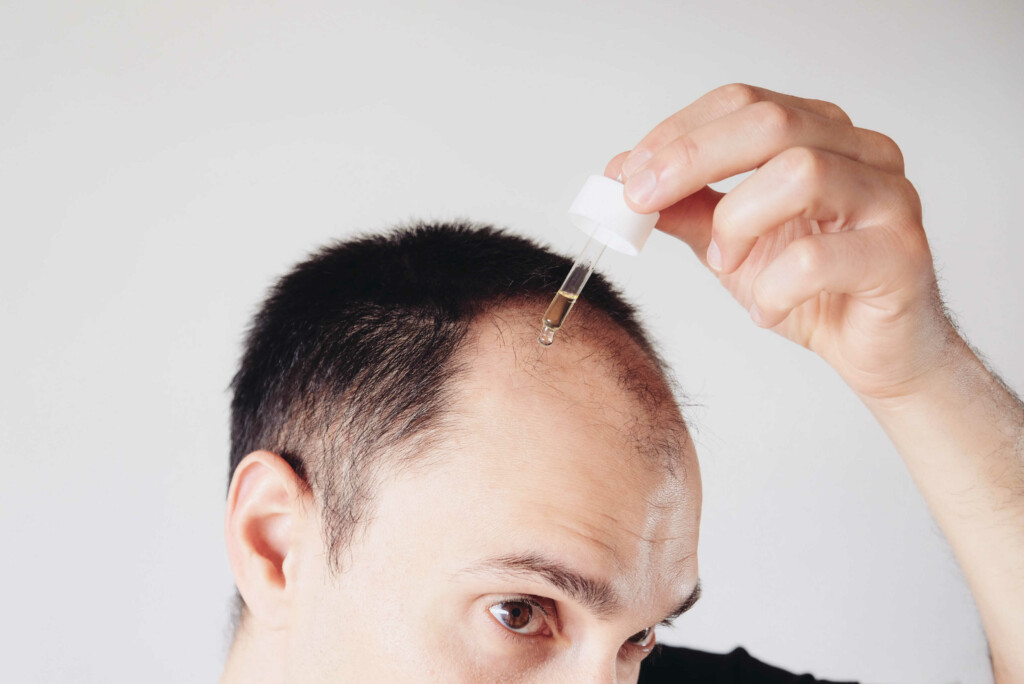Humans have hairs – and hair follicles – all over their bodies. The long, clearly visible, darker hairs are known as terminal hairs. The short, thin, pale hairs that exist across bodies and faces are known as vellus hairs. You’ve probably heard of vellus hairs referred to by more colloquial names, like “peach fuzz” or “baby hairs”.
When boys go through puberty, hormones prompt many of their vellus hairs turn into terminal hairs. And when men experience pattern hair loss, the reverse occurs: Terminal hairs gradually turn into vellus hairs. Eventually, they stop producing hair completely, resulting in baldness. The only way to stop this progression is to start using a hair loss treatment.
What is vellus hair?
Vellus hairs are the short, wispy, almost invisible hairs covering your body. Vellus hairs’ length, thickness, and color can vary between people – but they are usually almost invisible because they lack pigment. (1)
Vellus hairs can be found almost everywhere – including your face, neck, arms, legs, and torso. The only place they don’t grow are the soles of your feet, palms of your hands, eyelids and lips.
Why do people have vellus hairs?
Vellus hairs help with thermoregulation: They help keep your skin cool when you’re warm and sweaty, and also help keep your skin warm when you’re cold. Each vellus hair also plays a role in sensation and perception. They allow you to perceive the sensation of having goosebumps and other light sensations across your skin.
You likely noticed your hair changing during puberty. This was due to hormones affecting your vellus hairs. Androgens, a type of sex hormone, cause vellus hairs to become terminal hairs.
The transition of vellus hair to terminal hair is why you develop coarse, dark hairs on your armpits, around your genitals, and your face at this stage in your life. Many people also see an increase in longer, darker, thicker hairs across their upper back, chest, arms, legs, hands, and feet.
As you get older, vellus hairs usually seem to go away. They either fall out or get shorter. But some people notice an increase in vellus hairs – specifically, a reduction in the terminal hairs found on their heads, and the appearance of more vellus hairs in their place. This is a phenomenon called miniaturization that occurs to people experiencing androgenic alopecia, also known as pattern hair loss.
Like the transition from vellus hair to terminal hair during puberty, the transition from terminal hair to vellus hair caused by androgenic alopecia is gradual. You’ll likely only notice it when you start to see more distinctive pattern hair loss symptoms, like changes to your hairline and hair loss around your temples and the crown of your head.
What is terminal hair?
Terminal hairs are thick, coarse hairs – like the hairs that grow on your scalp. You can also easily see terminal hairs on your eyebrows, eyelashes, pubic region, and armpits. People also tend to have distinctive terminal hairs growing on their arms, legs, belly, back, and chest. In fact, 90 percent of men’s bodies are covered in terminal hairs. (2)
Vellus hair and terminal hair can grow side by side, and both protect the body by supporting thermoregulation, but they’re fundamentally different. Besides being longer and darker than vellus hairs, terminal hairs are also buried deeper in the skin. Terminal hairs also grow faster than vellus hairs, at a rate of approximately 1 centimeter (0.4 inches) per month.
Why does hair miniaturization occur?
Hair miniaturization occurs when an androgen known as dihydrotestosterone (DHT) binds to hair follicles. According to a journal article, this process leads to a gradual shrinkage of the hair follicle, which had been producing terminal hairs. (3) This, in turn, leads to the production of thinner, shorter, weaker hair strands.
Over time, hair follicles stop producing strong, long, healthy terminal hair strands and only produce thin, wispy vellus hair. This issue commonly occurs to people with androgenic alopecia, but can sometimes occur to people with other types of hair loss, too.
Hair follicle miniaturization is also caused by a change to some of the cells surrounding the follicle. DHT causes certain growth factors around hair follicles to stop being produced, which affects their neighboring skin cells and accelerates the transition from terminal hair to vellus hair. This is also part of the reason hair follicles eventually become dormant and stop producing hairs altogether.
You should know that DHT isn’t the sole culprit behind androgenic alopecia. This form of hair loss also has a strong genetic component. Multiple genes are thought to be involved in the inheritance and severity of pattern hair loss.
Turning vellus hair into terminal hair
Hair follicle miniaturization and hair loss aren’t necessarily permanent. You can stop this process by blocking the effects of DHT, which can help reverse the miniaturization process. Alternatively, you can also stimulate hair follicles and allow more nutrients and oxygen to reach them, which improves follicular health and allows for stronger, healthier hairs to grow.
Three hair loss treatments are currently approved by the Food and Drug Administration: minoxidil, finasteride, and laser hair therapy. (4) Minoxidil and finasteride are both medications, while laser hair therapy is administered using a device.
Minoxidil and laser hair therapy both allow more nutrients and oxygen to reach the scalp and hair follicles. Both of these are applied directly to the scalp. Minoxidil is a medication that’s applied as a topical foam or liquid, while laser hair therapy requires the use of devices (like caps or combs) that emit biostimulatory wavelengths of light.
Finasteride works as a DHT blocker, reducing levels of DHT in order to stop this hormone from binding to hair follicles. This drug is taken orally, once a day, in doses of 1 milligram.
DHT blockers stop miniaturization
Finasteride is an effective way to stop follicular miniaturization and block DHT. However, since this drug is taken orally, it also affects DHT levels across other parts of the body. DHT levels in blood may be reduced by up to 70 percent. (5)
DHT is bad for hair follicles, but it’s not doing harm to other parts of your body. In fact, quite the opposite. When DHT levels are reduced systemically, it causes an array of negative side effects, including breast tissue growth, erectile dysfunction, loss of libido, and decreased ejaculatory volume. Finasteride has also been associated with non-sexual side effects, like skin rashes, dizziness, shortness of breath, and weakness.
The wide array of potential side effects that finasteride causes can be of great concern to many men. While minoxidil and laser hair therapy devices don’t work in the same way, they also don’t have any of the same side effects – making them much more appealing when choosing a long-term hair loss treatment.
Another alternative is to use a topical DHT blocker. According to a review, natural DHT blockers like saw palmetto are becoming popular alternatives to finasteride. (6)
Saw palmetto is a weaker DHT blocker than finasteride, which means that taking it results in fewer side effects. It’s also been shown to be effective when applied topically, increasing its positive effect on hair follicles and reducing its potential to cause systemic issues. However, you should know that this natural DHT blocker has yet to be granted FDA approval as a hair loss treatment.
Vellus hair vs. terminal hair
Vellus hair and terminal hair are very similar. They both grow from hair follicles and help the human body regulate temperature in hot and cold environments. They’re also found across the body in various places – like the face, arms, legs, and torso.
Most people have at least some terminal hairs since the time of their birth. But vellus hairs are the primary type of hair people have until they reach puberty, when more terminal hairs develop.
People with pattern hair loss experience a reversal in which terminal hairs gradually shrink until they become vellus hairs. This miniaturization process occurs due to DHT binding to hair follicles.
If you’ve noticed an increase in the amount of vellus hairs on your head and have been losing terminal hairs more frequently, you may have pattern hair loss. People with androgenic alopecia tend to see changes to their hairline, followed by hair loss around their temples and the crown of their head. You may also notice an increase in the number of vellus hair on the temples and crown of your scalp over time.
You can stop DHT from binding to your hair follicles by using a DHT blocker. Both FDA-approved prescription versions like finasteride, and unapproved natural DHT blockers like saw palmetto, exist. But since prescription DHT blockers have been linked to unpleasant side effects, you may want to consider other options.
It’s also possible to use non-prescription hair loss treatments like minoxidil, PEMF therapy and laser hair therapy devices. These hair loss treatments can help stop hair loss from progressing and encourage follicles to start regrowing hair.








